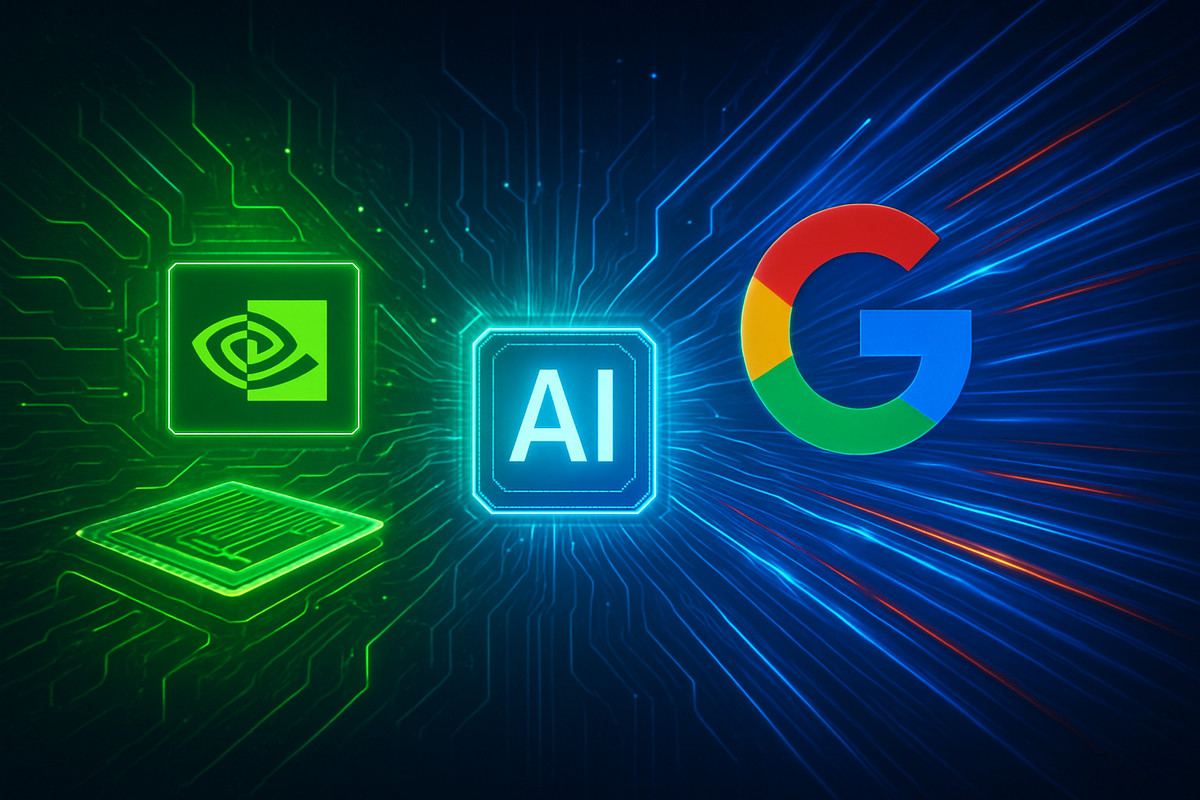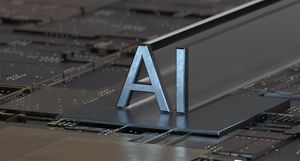
November 25, 2025 – The artificial intelligence landscape is witnessing an unprecedented acceleration of innovation and competition, with Nvidia (NASDAQ: NVDA), the long-standing titan of AI chips, now facing a formidable challenge from tech giant Alphabet (NASDAQ: GOOGL). As of late 2025, Alphabet's aggressive push with its custom-designed Tensor Processing Units (TPUs) and the highly advanced Gemini AI model is fundamentally reshaping the market, signaling a shift towards a more diversified and vertically integrated future for AI infrastructure. This intensifying rivalry is not merely a corporate skirmish but a foundational struggle for control over the entire AI stack, from silicon to software, with profound implications for market dynamics, public companies, and the future trajectory of artificial intelligence.
Nvidia has, for years, held a commanding lead in the AI chip market, particularly for data center GPUs essential for training and deploying complex AI models. However, Alphabet's decade-long investment in TPUs, coupled with the success of its multimodal Gemini models, is now moving beyond internal use, directly challenging Nvidia's dominance. Recent reports of major players like Meta Platforms considering Google's TPUs have sent ripples through the market, causing fluctuations in Nvidia's stock and bolstering investor confidence in Alphabet's integrated AI strategy. This battle for AI supremacy is set to redefine technological leadership and unlock new frontiers in artificial intelligence.
Alphabet's Ascent: A Deep Dive into TPUs and Gemini's Evolution
Alphabet's journey into custom AI silicon began nearly a decade ago, born from the necessity to power its burgeoning machine learning workloads more efficiently than traditional CPUs or even general-purpose GPUs. This strategic foresight has culminated in the sophisticated Tensor Processing Unit (TPU) lineup and the groundbreaking Gemini AI models, positioning Google as a vertically integrated powerhouse.
The Tensor Processing Units (TPUs) are application-specific integrated circuits (ASICs) meticulously engineered for neural network machine learning, optimized for Google's TensorFlow software. The timeline of their development highlights Google's persistent commitment:
- 2015: The first-generation TPU (v1) was deployed internally, primarily for accelerating AI inference.
- May 2016: Google CEO Sundar Pichai publicly announced TPUs, touting their superior performance per watt for machine learning.
- 2017-2021: Subsequent generations (v2, v3, v4) progressively enhanced capabilities, supporting both inference and training, and became available to Google Cloud customers.
- May 2024: The sixth-generation TPU, Trillium (v6e), was announced, offering a 4.7x performance increase over its predecessor and doubled High Bandwidth Memory (HBM) capacity, becoming available in preview by October 2024.
- April 2025: Google unveiled its seventh-generation TPU, Ironwood (v7), designed for high-speed AI inference and large-scale training, claiming over four times the performance of the previous generation.
- November 2025: Ironwood reached general availability, aggressively marketed for its lower costs and improved performance for AI developers, capable of scaling to massive 9,216-chip clusters.
Parallel to its hardware advancements, Google DeepMind developed the Gemini model, a family of multimodal large language models (LLMs) that natively processes text, images, audio, and video. Gemini's architecture uses a unified embedding space and a Mixture-of-Experts (MoE) design, representing a significant leap from earlier models like LaMDA and PaLM 2.
- May 2023: Gemini was first announced at Google I/O.
- December 2023: Gemini 1.0 launched, integrated into Bard and Pixel 8 Pro.
- February 2024 - June 2025: Subsequent versions (1.5, 2.0, 2.5) introduced long-context understanding, improved speed, multimodal live APIs, and enhanced reasoning.
- November 18, 2025: Google released Gemini 3.0 Pro and 3.0 Deep Think, reportedly outperforming major rivals, including OpenAI's GPT-5 Pro, in 19 out of 20 benchmarks.
Key players driving Google's (NASDAQ: GOOGL) AI hardware strategy include CEO Sundar Pichai, DeepMind CEO Demis Hassabis, and early TPU pioneers Jeff Dean and Andy Swing. Manufacturing partners like TSMC (Taiwan Semiconductor Manufacturing Co. Ltd.) and Broadcom (NASDAQ: AVGO) are crucial. Significantly, major AI players like Anthropic and potentially Meta Platforms (NASDAQ: META) are adopting Google Cloud TPUs, with Warren Buffett's Berkshire Hathaway (NYSE: BRK.A) making a multi-billion dollar investment in Alphabet, signaling strong confidence.
Initial market reactions as of late 2025 underscore the intensity of this competition. Google's aggressive externalization of TPUs, coupled with news of Meta's potential adoption, has led to dips in Nvidia's (NASDAQ: NVDA) stock and surges for Alphabet. TPUs are being actively promoted as a cheaper, more energy-efficient alternative, with early adopters like Anthropic reporting 35% cost reductions and Shopify achieving 2x faster inference speeds. This shift is creating a "Google Chain" ecosystem that is breaking down vendor lock-in and driving substantial revenue growth for Google Cloud, which saw a 34% year-over-year increase in Q3 2025.
Meanwhile, Nvidia continues to innovate with its Blackwell platform, a cutting-edge GPU microarchitecture succeeding Hopper. Announced in March 2024 and launched in Q4 2024, Blackwell features 208 billion transistors, promises a 30-times performance increase over the H100 for generative AI, and significantly lower cost and power consumption. Major cloud providers like Amazon Web Services (AWS), Google Cloud, and Microsoft Corp. (NASDAQ: MSFT) are already offering access to Blackwell GPUs, demonstrating its broad industry adoption and Nvidia's commitment to maintaining its leadership.
Winners and Losers in the AI Arms Race
The escalating AI chip and model competition between Nvidia (NASDAQ: NVDA) and Alphabet (NASDAQ: GOOGL) is poised to redistribute market share and influence strategic directions across the tech industry.
Companies Likely to Win:
- Alphabet (NASDAQ: GOOGL): Alphabet stands as a significant winner due to its robust vertical integration strategy. Google Cloud, fueled by AI infrastructure demand, saw substantial revenue growth, projected to hit $100 billion by 2025. Its Ironwood TPUs directly challenge Nvidia's offerings, potentially capturing up to 10% of Nvidia's annual data center revenue through deals with companies like Anthropic and the rumored Meta Platforms (NASDAQ: META) partnership. Alphabet's stock has surged, reflecting investor optimism in its Gemini 3 AI model and strategic infrastructure. Its "AI-first" strategy, backed by massive capital expenditures on AI infrastructure, aims to integrate AI across all its products, reducing reliance on external vendors and enhancing cost control.
- Enterprises and AI Developers: The intensified competition benefits end-users by providing more diverse options and potentially lower costs for AI compute. Access to cost-effective TPU-based solutions from Google Cloud offers a viable alternative to Nvidia's often expensive and supply-constrained GPUs, enabling greater flexibility and faster innovation cycles in AI development.
- AI Software and Model Developers Leveraging Diverse Hardware: Developers proficient in multiple AI frameworks (e.g., PyTorch, JAX, TensorFlow for TPUs alongside CUDA for Nvidia GPUs) will find broader opportunities. This encourages the creation of more hardware-agnostic AI software and solutions optimized for specific platforms, maximizing efficiency.
Companies Facing Challenges or Nuanced Impacts:
- Nvidia (NASDAQ: NVDA): While still a dominant force, Nvidia faces increasing competitive pressure. Major customers, including Alphabet, Amazon (NASDAQ: AMZN), and Microsoft (NASDAQ: MSFT), are developing their own chips to reduce reliance, potentially eroding Nvidia's pricing power and market share in the long term. Reports of Meta considering Google's TPUs directly impacted Nvidia's stock. Nvidia's strategy emphasizes its full-stack ecosystem, including CUDA software, networking, and the "AI factory" concept, and it is expanding into "Physical AI" (robotics, autonomous vehicles) to maintain its indispensable position.
- Other Cloud Providers (Microsoft Azure, Amazon Web Services): These hyperscalers are in a complex position. While they remain major customers of Nvidia, they are also heavily investing in their own custom AI silicon (e.g., Amazon's Trainium/Inferentia, Microsoft's Project Athena) to control costs and offer differentiated services. Google Cloud's aggressive expansion with TPUs poses a direct competitive threat to their market share in AI cloud services. Their success will depend on balancing external chip reliance with successful internal chip development and competitive cloud AI offerings.
- Other Chip Manufacturers (AMD, Intel): Advanced Micro Devices (NASDAQ: AMD) and Intel (NASDAQ: INTC) face pressure to innovate and gain market share against Nvidia's dominance and Alphabet's vertical integration. AMD's MI300X AI accelerator is gaining traction, while Intel is focusing on AI PCs. However, Nvidia's sustained lead and Google's introduction of Axion CPUs challenge the x86 architecture historically dominated by Intel and AMD. Their stock performance hinges on their ability to capture meaningful market share and differentiate their offerings.
Overall, the market is moving towards diversification of AI compute, with hyperscalers actively seeking to reduce over-reliance on a single vendor. Vertical integration is becoming a key strategy for major tech companies to gain efficiency and control costs. While Nvidia's CUDA remains a formidable competitive moat, Google's focus on open frameworks and its own developer tools aims to attract a broad developer base, making cost-efficiency and performance-per-watt critical differentiators.
The Wider Significance: Reshaping the AI Landscape
The intensifying competition between Nvidia (NASDAQ: NVDA) and Alphabet (NASDAQ: GOOGL) in the AI chip and model market is far more than a corporate rivalry; it's a pivotal moment that is fundamentally reshaping the technological landscape. This contest underscores a strategic pivot towards diversification of supply and deep vertical integration, driven by the colossal demand for AI compute, with the global AI chip market projected to reach $92 billion in 2025 and potentially $295.56 billion by 2030. The core significance lies in the battle for control over the entire AI stack, from silicon to software and services.
Broader Industry Trends:
- Vertical Integration as the New Standard: Both Nvidia and Alphabet are aggressively pursuing vertical integration. Alphabet's decade-long development of TPUs, its data centers, and the integration of hardware into products like Gemini and Google Cloud illustrate a comprehensive strategy to gain efficiency, reduce costs, and secure its long-term competitive advantage. Nvidia, while known for GPUs, has also expanded into offering entire "AI supercomputers" and its comprehensive CUDA software ecosystem, creating significant barriers to entry. This trend mirrors Apple's (NASDAQ: AAPL) long-standing strategy of integrating hardware, software, and services for optimized performance and a defensible ecosystem.
- Diversification of Supply Chains: The immense demand for AI chips and past supply bottlenecks have spurred major tech companies to diversify their AI hardware supply chains. Google is actively promoting its TPUs as a cost-effective alternative, with Meta Platforms (NASDAQ: META) reportedly considering using Google's TPUs, and Anthropic already committing to one million TPUs. Beyond Google, Amazon (NASDAQ: AMZN) (Trainium, Inferentia) and Microsoft (NASDAQ: MSFT) (Project Athena) are developing their own custom AI accelerators, and OpenAI has partnered with Broadcom (NASDAQ: AVGO). This trend reflects a realization that specialized ASICs can offer greater efficiency for specific AI workloads.
Potential Ripple Effects:
- On Competitors: Nvidia's market dominance faces pressure from custom ASICs and Google's aggressive TPU strategy, potentially impacting its long-term pricing power. Competitors like AMD (NASDAQ: AMD) and Intel (NASDAQ: INTC) are pushed to innovate faster and seek strategic partnerships. The emergence of specialized AI cloud providers ("neoclouds") offering alternatives benefits AI startups by lowering compute costs.
- On Partners: Cloud providers like AWS, Microsoft Azure, and Google Cloud are Nvidia's largest customers, yet they are also developing their own custom AI chips, creating a "frenemy" dynamic. While Nvidia's CUDA ecosystem creates high switching costs, efforts like Google's vLLM TPU aim to provide more flexibility for PyTorch and JAX users.
Emerging Regulatory or Policy Implications:
The concentration of AI computing power and market influence is attracting increasing scrutiny. The U.S. Department of Justice has reportedly initiated an investigation into Nvidia for potential antitrust violations, reflecting concerns about its market dominance. Alphabet's growing AI market share, coupled with its cloud infrastructure, could revive scrutiny regarding competition and data usage. Furthermore, geopolitical tensions, particularly between the U.S. and China, continue to shape the AI chip market, influencing export controls and encouraging the development of homegrown alternatives.
Historical Precedents:
This AI chip and model competition draws parallels with transformative periods in tech history:
- Apple's Vertical Integration: A classic example of controlling the full stack.
- Intel vs. AMD in CPUs: A long-standing rivalry that drove continuous innovation.
- The Browser Wars (Microsoft Internet Explorer vs. Netscape Navigator) and Operating System Dominance (Microsoft Windows): Illustrate how control over foundational technologies and ecosystems confers immense power and creates lock-in effects, similar to Nvidia's CUDA.
- Early Semiconductor Industry: The shift towards specialized ASICs from general-purpose CPUs mirrors earlier trends where custom chips were developed for greater efficiency.
In essence, the Nvidia-Alphabet AI competition is a foundational struggle for the future of artificial intelligence, highlighting the critical importance of owning the full technology stack, fostering diversification in vital supply chains, and navigating an increasingly complex regulatory and geopolitical environment.
What Comes Next: The Future Trajectory of AI Competition
The intensified competition between Nvidia (NASDAQ: NVDA) and Alphabet (NASDAQ: GOOGL) is setting the stage for a dynamic and rapidly evolving AI landscape. As of late 2025, both companies are deeply entrenched in aggressive strategies that will shape the future of AI hardware, software, and services.
Short-Term Possibilities (Late 2025 - 2026):
- Nvidia's Continued Hardware Leadership: Nvidia will continue to push its aggressive GPU roadmap. The Blackwell Ultra GPU architecture, designed for agentic AI and physical AI, is expected to debut in the second half of 2025, followed by the Rubin platform in 2026, promising significant performance enhancements. Nvidia is also advancing its software stack with open-source inference frameworks like Dynamo and expanding AI Blueprints for enterprise workflows.
- Alphabet's Aggressive TPU Externalization: Alphabet's primary short-term pivot is the aggressive expansion of its seventh-generation Ironwood TPU beyond internal use. Its general availability in November 2025, coupled with lower costs and improved performance, positions it as a direct challenge to Nvidia. The rumored deal with Meta Platforms (NASDAQ: META) for TPU rentals in 2026 and purchases in 2027, along with Anthropic's commitment to one million TPUs, signifies a major shift in the AI hardware supply chain. Google's Arm-based Axion CPUs will also gain traction for general cloud computing.
Long-Term Possibilities (Beyond 2026):
- Nvidia's Full-Stack AI Platform: Nvidia's long-term vision involves an annual cadence of new architectures, with Rubin Ultra in 2027 and Feynman beyond, continuously pushing hardware performance. The company will further invest in its comprehensive software stack (CUDA-X, NeMo, Nemotron, Riva, cuOpt, Cosmos) and its "physical AI" initiatives for robotics and autonomous vehicles, aiming to make its platform indispensable.
- Alphabet's Deepened Vertical Integration: Alphabet will continue to leverage its control over the entire AI stack—from chip design (TPUs, Axion) and manufacturing partnerships (TSMC, Broadcom) to cloud infrastructure and AI model development (Gemini). Massive capital expenditures in AI infrastructure are projected to significantly increase in 2026, with ambitious projects like Project Suncatcher, aiming to launch TPU-equipped satellites by 2027 for space-based AI clusters. Google will also intensely focus on optimizing TPUs for inference workloads, which are expected to see exponential growth.
Strategic Pivots and Adaptations:
- Nvidia: Will likely emphasize its software and services, diversifying into agentic and physical AI, and forming strategic partnerships to ensure its chips remain integral to broader cloud offerings.
- Alphabet: Will aggressively expand TPU adoption, optimize for inference, and deepen its vertical integration to offer highly optimized and cost-effective AI solutions.
- Competitors: AMD (NASDAQ: AMD) and Intel (NASDAQ: INTC) will need to focus on niche markets, cost-effectiveness, and robust software support to compete effectively. Hyperscalers like Amazon and Microsoft will continue developing their custom AI silicon.
Emerging Market Opportunities and Challenges:
- Agentic AI and Multimodal AI: Both companies are heavily invested in these areas, promising autonomous systems and richer AI applications across industries.
- Sovereign AI and Edge AI: Growing demand for data control and real-time processing at the network's edge will create new market segments.
- Ethical AI and Regulation: As AI becomes pervasive, ethical considerations, privacy, and fairness will become critical challenges, potentially leading to increased regulatory scrutiny.
- High Investment Costs: The immense capital expenditures required for AI infrastructure will remain a barrier for smaller players.
Potential Scenarios and Outcomes:
- Dual Dominance with Market Segmentation: Nvidia leads in high-end AI training, while Alphabet's TPUs gain traction in specific workloads, especially inference and within Google Cloud.
- Increased Vertical Integration as the Norm: More tech giants will follow Alphabet's lead, designing their own custom AI chips.
- The "Software Layer" Battleground: The long-term differentiator might shift to software ecosystems, with Nvidia's CUDA battling Google's TensorFlow, JAX, and Gemini models for developer mindshare.
- Rise of AI-as-a-Service (AIaaS): Cloud providers will become even more critical, offering powerful AI compute and models as services.
- Accelerated AI Capabilities: Intense competition will drive rapid advancements in AI chip performance, energy efficiency, and model capabilities, transforming numerous industries.
The coming years will likely see a more diverse AI hardware market, where performance, cost-efficiency, software ecosystems, and strategic partnerships will dictate market share and influence the trajectory of AI innovation.
Comprehensive Wrap-up: A New Era of AI Competition
The latter half of 2025 has cemented a new era of intense competition in the AI chip and model market, with Nvidia (NASDAQ: NVDA) and Alphabet (NASDAQ: GOOGL) at its epicenter. This rivalry is not merely a contest for market share but a fundamental redefinition of how artificial intelligence infrastructure will be built, deployed, and monetized globally.
Key Takeaways:
- Nvidia's Enduring Innovation: Nvidia continues to push the boundaries of AI hardware with its Blackwell Ultra GPU architecture, expected in late 2025, and the upcoming Rubin platform in 2026. The launch of its GeForce RTX 50 Series GPUs and advancements in "physical AI" through Project DIGITS and Isaac GR00T underscore its commitment to maintaining leadership across consumer and enterprise segments. Nvidia's strategic investment in Anthropic (alongside Microsoft) further solidifies its ecosystem.
- Alphabet's Vertical Integration Triumph: Alphabet's decade-long investment in custom silicon has matured spectacularly. The general availability of its seventh-generation Ironwood TPU in November 2025, coupled with the release of the highly competitive Gemini 3.0 AI model, showcases a powerful vertically integrated strategy. This approach allows Google to control costs, optimize performance, and offer a compelling alternative to Nvidia, as evidenced by the potential multi-billion dollar deal with Meta Platforms (NASDAQ: META) for TPU adoption. Warren Buffett's multi-billion dollar investment in Alphabet further validates this strategy.
- Shifting Alliances and Ecosystems: The landscape of strategic partnerships is evolving. While Nvidia forms alliances to extend its CUDA ecosystem, Alphabet's aggressive externalization of TPUs is creating new competitive dynamics, potentially reshaping the allegiances of major AI infrastructure spenders.
Assessment of the Market Moving Forward:
The AI chip market is experiencing unprecedented growth, projected to hit nearly $92 billion in 2025 and exceed $100 billion in the first half of 2026. While Nvidia still commands a significant share, Alphabet's aggressive, vertically integrated approach is fostering a more fragmented and competitive landscape. The market for inference-optimized chips is expected to outpace training, driving demand for specialized accelerators. The trend towards edge computing and sovereign AI solutions will also spur new forms of competition and innovation.
Significance and Lasting Impact:
This rivalry marks a critical juncture in the AI revolution. Nvidia's strength lies in its comprehensive CUDA software platform, which has made its GPUs the default choice. However, Alphabet's strategy of designing its own chips and deeply integrating them into Google Cloud and its AI models provides significant efficiency gains and reduces reliance on external suppliers. This vertical integration could gradually shift cloud market dynamics, attracting third-party training due to cost and performance advantages. The intense competition is a net positive for the broader AI industry, driving rapid advancements in chip performance, software optimization, and overall AI infrastructure, leading to more cost-effective and diverse AI solutions.
What Investors Should Watch For in the Coming Months:
- Stock Performance: Investors should closely monitor the stock performance of both Nvidia (NASDAQ: NVDA) and Alphabet (NASDAQ: GOOGL/GOOG). Nvidia's stock, having recently hit a $5 trillion market cap, will be scrutinized for its Q4 FY26 guidance and the adoption rate of its Blackwell architecture. Alphabet's stock, which recently crossed $300, will be influenced by further news regarding Gemini 3's integration and the success of its TPU externalization strategy, particularly any concrete agreements with Meta Platforms.
- Strategic Partnerships: Observe any further announcements regarding major tech companies adopting Google's TPUs, as these will be strong indicators of shifting allegiances. Similarly, Nvidia's ongoing collaborations with AI startups and cloud providers will be crucial in maintaining its ecosystem dominance. The extent of Anthropic's utilization of both Nvidia's architecture and Google Cloud's compute capacity will also provide key insights.
- Technological Advancements: Keep an eye on the official release and performance benchmarks of Nvidia's Blackwell Ultra products in late 2025 and updates on its Rubin platform for 2026. For Alphabet, monitor the continued evolution of Gemini models and their deeper integration across Google's services, alongside the adoption rates and performance of the Ironwood TPUs by Google Cloud customers and external partners.
The intensified competition between Nvidia and Alphabet in late 2025 is reshaping the AI landscape, moving towards a future where specialized, in-house chip designs play an increasingly critical role. Investors must keenly watch not just hardware advancements, but also strategic alliances and the broader ecosystem plays of these tech titans.
This content is intended for informational purposes only and is not financial advice






